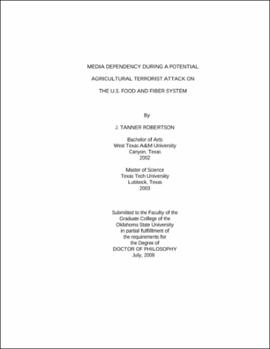| dc.contributor.advisor | Cartmell, D. Dwayne, II | |
| dc.contributor.author | Robertson, J. Tanner | |
| dc.date.accessioned | 2013-11-26T08:22:21Z | |
| dc.date.available | 2013-11-26T08:22:21Z | |
| dc.date.issued | 2009-07 | |
| dc.identifier.uri | https://hdl.handle.net/11244/6571 | |
| dc.description.abstract | Scope and Method of Study: | |
| dc.description.abstract | This study sought to determine individuals' media dependency as it relates to a potential terrorist attack on the U.S. food and fiber system. The scope of this study was limited to former students of Oklahoma State University who voluntarily released their e-mail address to the alumni association. The method of research was a multiple regression study using measures of media dependency as dependent variables and measures of degree of perceived threat and knowledge of agriculture as independent variables. | |
| dc.description.abstract | Findings and Conclusions: | |
| dc.description.abstract | Demographic information indicated respondents were employed (67.3%), white (92.8%), and had at least a bachelor's degree (96.9%). Respondents spent about nine hours a week on the Internet and nine hours a week watching television for news information. Selected news medium dependencies were predicted best by normal media use by respondents. R-square values indicated the effects of normal media use on individual media dependencies were small (Cohen, 1988). However, with normal media use added to the model, normal media use was statistically significant in predicting media dependency for television (β = .151), radio (β = .093), Internet (β = .159) and print (β = .131). Degree of Threat was a statistically significant predictor of Total Media Dependency, Dependency for Social Understanding, and Dependency for Action Orientation. With Degree of Threat added to the model, R-square values indicated about 3% of the variance for Total Media Dependency was explained. Small effect sizes were found for Dependency for Social Understanding (R2 = .032) and Dependency for Action Orientation (R2 = .023) as well. A general understanding of the food and fiber system was not a significant predictor of Total Media Dependency. When Total Knowledge Scores were added to the model, no statistical significance was present. | |
| dc.format | application/pdf | |
| dc.language | en_US | |
| dc.rights | Copyright is held by the author who has granted the Oklahoma State University Library the non-exclusive right to share this material in its institutional repository. Contact Digital Library Services at lib-dls@okstate.edu or 405-744-9161 for the permission policy on the use, reproduction or distribution of this material. | |
| dc.title | Media dependency during a potential agricultural terrorist attack on the U.S. food and fiber system | |
| dc.contributor.committeeMember | Leising, James G. | |
| dc.contributor.committeeMember | Blackwell, Cindy Southard | |
| dc.contributor.committeeMember | Montgomery, Diane | |
| osu.filename | Robertson_okstate_0664D_10419.pdf | |
| osu.accesstype | Open Access | |
| dc.type.genre | Dissertation | |
| dc.type.material | Text | |
| thesis.degree.discipline | Agricultural Education | |
| thesis.degree.grantor | Oklahoma State University | |
